|
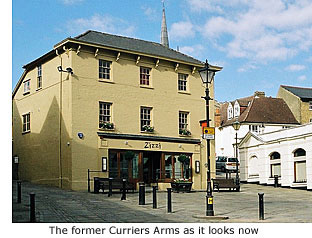 The large, three-storey building at the top of Market Square is currently a restaurant. From the early 1900s until the 1980s Clement Joscelyne’s traded from here, latterly under the name ‘The Other Place’, but long before Joscelyne's ownership it was the Curriers Arms public house. Its name was derived from the leather trade that once flourished in this area, carried out, perhaps, in either of the adjacent yards. A Currier dressed and coloured tanned leather (See Guide 6 – The Leather Industry). The property, probably early 18th century, is first recorded in the will of one James Meredith, husbandman of Little Hadham, who died in 1771. His bequest was that the freehold of the Curriers Arms should go to his wife, Elizabeth, and that when she died it was to go to their son James. Whether or not the son survived to inherit the pub is unknown The large, three-storey building at the top of Market Square is currently a restaurant. From the early 1900s until the 1980s Clement Joscelyne’s traded from here, latterly under the name ‘The Other Place’, but long before Joscelyne's ownership it was the Curriers Arms public house. Its name was derived from the leather trade that once flourished in this area, carried out, perhaps, in either of the adjacent yards. A Currier dressed and coloured tanned leather (See Guide 6 – The Leather Industry). The property, probably early 18th century, is first recorded in the will of one James Meredith, husbandman of Little Hadham, who died in 1771. His bequest was that the freehold of the Curriers Arms should go to his wife, Elizabeth, and that when she died it was to go to their son James. Whether or not the son survived to inherit the pub is unknown
The landlord in 1830 was James Franklin, who the following year appeared at Hertford Assizes accused of murdering his wife, Mary. He may or may not have been guilty of her murder but, fortunately for him, the presiding judge was unimpressed with evidence given by a young witness to the crime and acquitted Franklin of all charges.
Like most drinking houses in Bishop's Stortford in the 1800s the Curriers Arms was eventually owned by the town's largest brewery, 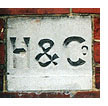 Hawkes & Co – confirmation of which can be found on the building's north wall where a small terracotta plaque bears the initials H&Co. It was on this side that a smaller building, once housing an antique shop and later a barbers, adjoined the pub. This was demolished in the early 1900s and later replaced by the public convenience that now occupies its former site. When the Curriers Arms closed in 1904 its wine and spirits licence was transferred to the Nags Head public house at Dunmow Road, and in April that year the property was sold at auction by G E Sworders & Sons for £1500. Hawkes & Co – confirmation of which can be found on the building's north wall where a small terracotta plaque bears the initials H&Co. It was on this side that a smaller building, once housing an antique shop and later a barbers, adjoined the pub. This was demolished in the early 1900s and later replaced by the public convenience that now occupies its former site. When the Curriers Arms closed in 1904 its wine and spirits licence was transferred to the Nags Head public house at Dunmow Road, and in April that year the property was sold at auction by G E Sworders & Sons for £1500.
Property prices, of course, have escalated since 1904. When this same property was sold at public auction in London in 2009, it went for £1.25m.
The buyer in 1904 was a Mr T Swatheridge, acting on behalf of the Rhodes Memorial Committee. As a lasting memorial to Cecil Rhodes who died in 1902, they proposed to demolish the pub and replace it with public assembly rooms and a drill hall, funded by public subscription. Disagreements within the committee, however, led to several members resigning and many subscriptions being cancelled. The remaining fund of £3,000 was too little to complete the project and so only the drill hall was built. This still stands at the rear of the building. Constructed of red brick in 1906 it was designed to accommodate pre-war volunteers and their horses, the original doorway (now filled in with windows) made large enough to admit horse-drawn wagons.
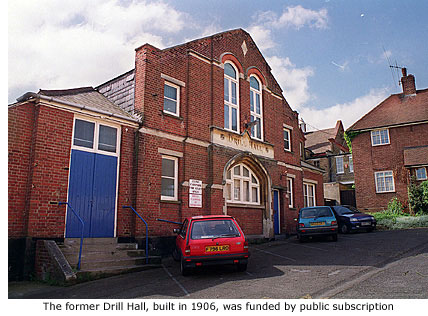 In the 1930s the hall was a regular venue for Saturday night dances and in 1947, when the Territorial Army was re-formed, became home to No 3 Company 1st Battalion Hertfordshire Regiment. This was disbanded in 1950 when the town ceased to be used as an army base. The Mitre Jazz Club (See Guide 13 – Holy Trinity Church Hall) held just one meeting here in September 1958. In the 1930s the hall was a regular venue for Saturday night dances and in 1947, when the Territorial Army was re-formed, became home to No 3 Company 1st Battalion Hertfordshire Regiment. This was disbanded in 1950 when the town ceased to be used as an army base. The Mitre Jazz Club (See Guide 13 – Holy Trinity Church Hall) held just one meeting here in September 1958.
At the rear of the Corn Exchange, the building currently housing a restaurant was originally the Castle public house – first mentioned in churchwardens’ accounts of 1681 when landlord Henry Wallis paid 6d rent. It was named as such because of its premier position overlooking the site of Waytemore Castle, but closed in the early 1800s to be resurrected in New Town where it has been ever since (See Guide 14 – New Town).
Beyond this building a courtyard once formed part of the property of No 8, owned from the early 1900s until his death by Charles Brazier. A builder and plumber by trade he was the brother of former landlord of the Chequers Hotel, Joe Brazier (See Guide 6 – No 19 Sworders).
Charles Brazier died 12 July 1942, aged 66, following an operation after a few days illness. As a boy he had been a member of St Michael's church choir and as a young man a Herts Territorial for 7 years. In later life he was prominent in public affairs; being vice-chairman of the Conservative Club, a director of Herts & Essex Building Society, a post warden in the ARP Service during the war and a member of Bishop's Stortford Fire Brigade for 35 years. In 1930 he became the People's Churchwarden for St Michael's.
Tucked into one corner of this yard stands the Tenter Barn, a timber-framed structure thought to be of 16th or 17th century origin and probably once used by Charles Brazier as stables. It was bought by Clement Joscelyne in the early 1900s for use as storage, and sold by them in the late 1980s. Now converted to private accommodation, this barn is the only tangible reminder of the early market place.
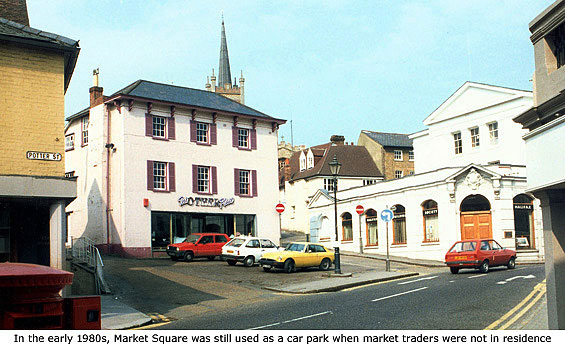
The name ‘tenter’ is associated with cloth making: derived from the Latin ‘tentorium’ meaning ‘shelter made of stretched skins’ and later defined as ’a framework with hooks used for stretching and dyeing cloth’. It was a process used primarily by textile workers to prevent cloth from shrinking. In Middle English ‘tenter’ was tentour or teyntur, and in Stortford’s medieval market place we had Teynter (Teyntur or Tenter) Hill – now Church Street – where it must be assumed cloth and fabrics were sold and possibly made (See Guide 15 – Church Street).
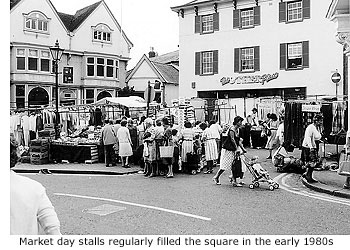 There is no evidence to suggest that cloth was manufactured in the market square itself, but between the 15th and early 19th century this particular area was noted for its leather trade. This is borne out by the naming of the 18th century Curriers Arms public house, giving every indication that curriers dressed and coloured tanned leather here. Any shelter used for the dyeing and drying of animal skins may well have been named a Tenter, hence the naming of this barn. There is no evidence to suggest that cloth was manufactured in the market square itself, but between the 15th and early 19th century this particular area was noted for its leather trade. This is borne out by the naming of the 18th century Curriers Arms public house, giving every indication that curriers dressed and coloured tanned leather here. Any shelter used for the dyeing and drying of animal skins may well have been named a Tenter, hence the naming of this barn.
In the Middle Ages a person's surname often originated from their occupation, and in 13th century records several surnames can be found that relate to the production of textiles. Prominent is Textor, from the Latin 'textor' meaning 'weaver'. Corruptions of this surname are recorded as Textrix and Teytor. Another surname from that century is 'Tinctor', from the Old French 'teinturier' or 'tainterier' meaning 'dyer'. Of the several derivations of this surname, 'Teyntur' is also prominent and 'Tenter' can still be found as a place name in several English towns and cities with a history of cloth making.
* With the introduction of non-shrink fabrics Tenters became virtually obsolete, but the name lives on in the saying 'to be on tenterhooks' i.e. to be in a state of distress or suspense.
The house in which Charles Brazier lived had previously been an alehouse called the Dog’s Head in the Pot, first recorded in 1643. The unusual name apparently referred to a dirty, slovenly housewife who, after letting her dog lick the cooking pot clean, then used its tail to wipe it dry. This may well have been a humorous interpretation but the alehouse also went by the names of the Dog’s Head and Pot, the Dog and Pot and the Dog’s Head. It closed in 1902. MORE PICTURES
|
|
 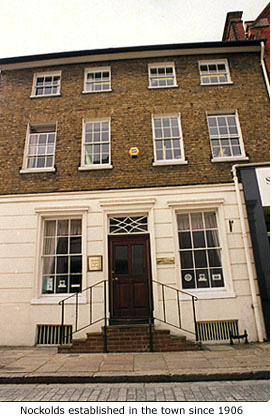 In medieval times the narrow road that runs behind the Corn Exchange was the town’s Fish Market, also known as Fish Row. It was still called as such at the beginning of the 17th century, at which time it featured in a decree made in the Bishop’s Court that stated 'no one having stalls or standings here should let them to any tanner or shoemaker'. The penalty to be imposed if they did so was 20 shillings (£1), though why such discrimination was applied to these tradesmen is a mystery. In medieval times the narrow road that runs behind the Corn Exchange was the town’s Fish Market, also known as Fish Row. It was still called as such at the beginning of the 17th century, at which time it featured in a decree made in the Bishop’s Court that stated 'no one having stalls or standings here should let them to any tanner or shoemaker'. The penalty to be imposed if they did so was 20 shillings (£1), though why such discrimination was applied to these tradesmen is a mystery.
This short road is now lined with buildings erected between the 17th and 19th century, and adjoining Robert Brazier’s old house is No 6, a yellow-bricked building owned by Nockolds the solicitors. Their entrance doorway is unpretentious but leads to a practice that occupies a maze of offices stretching the entire length of this terrace above the shops and businesses at ground-floor level. Testimony to the number of years Nockolds has been established here is their original brass nameplate alongside the front door – polished so often the engraving has almost been erased.
In the mid 19th century the premises was a wine shop owned by Frederick Charles Heath, who, when he retired, allowed it to be used in 1873 as a meeting place by the newly formed Bishop’s Stortford Working Men’s Club. The accommodation also included use of the wine cellar (still a part of the property), but when the building proved too small for the club’s large membership they moved, that same year, to larger premises in South Street (See Guide 15).
Mr Heath retained the property until 1879 and then sold it to local solicitor William Fitzroy Ackland who, according to the deeds, already had a tenancy in part of the building. It must be assumed the property then became the Stortford based practice of his firm, Ackland & Son (W F Ackland and his son B T L Ackland), the other practice being in nearby Sawbridgeworth.
The partnership was joined in 1880 by *Alfred Nockolds to become Ackland & Nockolds but after Mr Ackland senior retired in 1903 and his son died in 1906, Alfred Nockolds became the sole partner. He then took into partnership Arthur Campbell Wade, renaming the firm Nockolds and Wade, and in 1909 was joined by his son, Bryan. When Mr Wade retired in 1912, Bryan Nockold became a partner and the firm was renamed Nockolds & Son. Alfred Nockolds retired in the early 1920s and died in 1928, after which time Bryan Nockolds became the sole partner until his death on 13 July 1958. Robert John Lofts and Peter Olney Davies then took over the firm, both of whom had been articled to Bryan Nockold, and continued to practice under the name of Nockolds & Son. When they were joined by Peter’s brother, David Anthony Davies in 1964 (a former solicitor with BOAC and BEA), the firm’s name was changed to Nockolds. Although R J Lofts died in 1987 and Peter and David Davies later retired, the firm continues under the name Nockolds.
It is also believed that Ackland & Nockolds acquired the practice of Baker & Thorneycroft in the late 1880s or early 1900s, but the records in this connection are sparse. It is known, however, that Baker & Thorneycroft practised in Sawbridgeworth as well as in Bishop’s Stortford, and that the Nockolds family lived at Sawbridgeworth and practised there for a number of years.
A covered passageway, once a right of way between No 6 and No 4 and leading to Church Street, was relinquished by Ackland in 1888 and now forms a part of the latter’s premises. MORE PICTURES
* Alfred Nockolds was Captain of the local Fire Brigade in 1898.
*Thanks to Peter Davies and Michael Talbot for further information about Nockolds history.
Premier Travel (formerly Claydens)
Bishop's Stortford's first travel agency was Claydens in Market Square, the premises now occupied by Premier Travel. Opened by Eva Ashpole (nee Claydon) in 1959, the business operated for 20 years before being bought out by Premier Travel in 1979.
Eva Ashpole (aged 90 in 2006) was a railway booking clerk during the war and her husband ran an engineering firm, B J Ashpole Ltd, in Southmil Road. After starting as an agent for LNER (London & North Eastern Railway), she then otained licences for different types of travel. In 1964 she was granted a licence from the International Air Travel Association and was one of the first members to be admitted to the International Institute of Travel Agents.
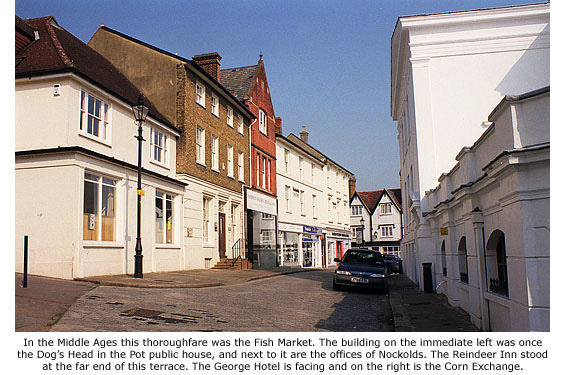
|


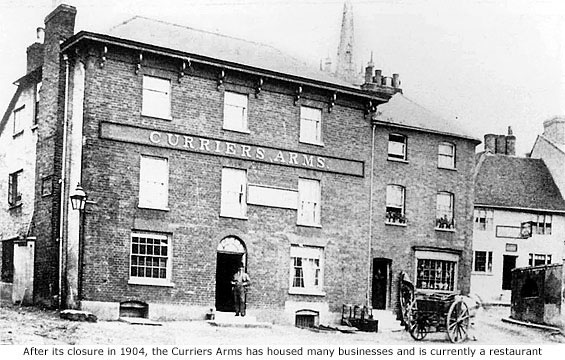

 The large, three-storey building at the top of Market Square is currently a restaurant. From the early 1900s until the 1980s Clement Joscelyne’s traded from here, latterly under the name ‘The Other Place’, but long before Joscelyne's ownership it was the Curriers Arms public house. Its name was derived from the leather trade that once flourished in this area, carried out, perhaps, in either of the adjacent yards. A Currier dressed and coloured tanned leather (See Guide 6 – The Leather Industry). The property, probably early 18th century, is first recorded in the will of one James Meredith, husbandman of Little Hadham, who died in 1771. His bequest was that the freehold of the Curriers Arms should go to his wife, Elizabeth, and that when she died it was to go to their son James. Whether or not the son survived to inherit the pub is unknown
The large, three-storey building at the top of Market Square is currently a restaurant. From the early 1900s until the 1980s Clement Joscelyne’s traded from here, latterly under the name ‘The Other Place’, but long before Joscelyne's ownership it was the Curriers Arms public house. Its name was derived from the leather trade that once flourished in this area, carried out, perhaps, in either of the adjacent yards. A Currier dressed and coloured tanned leather (See Guide 6 – The Leather Industry). The property, probably early 18th century, is first recorded in the will of one James Meredith, husbandman of Little Hadham, who died in 1771. His bequest was that the freehold of the Curriers Arms should go to his wife, Elizabeth, and that when she died it was to go to their son James. Whether or not the son survived to inherit the pub is unknown Hawkes & Co – confirmation of which can be found on the building's north wall where a small terracotta plaque bears the initials H&Co. It was on this side that a smaller building, once housing an antique shop and later a barbers, adjoined the pub. This was demolished in the early 1900s and later replaced by the public convenience that now occupies its former site. When the Curriers Arms closed in 1904 its wine and spirits licence was transferred to the Nags Head public house at Dunmow Road, and in April that year the property was sold at auction by G E Sworders & Sons for £1500.
Hawkes & Co – confirmation of which can be found on the building's north wall where a small terracotta plaque bears the initials H&Co. It was on this side that a smaller building, once housing an antique shop and later a barbers, adjoined the pub. This was demolished in the early 1900s and later replaced by the public convenience that now occupies its former site. When the Curriers Arms closed in 1904 its wine and spirits licence was transferred to the Nags Head public house at Dunmow Road, and in April that year the property was sold at auction by G E Sworders & Sons for £1500. In the 1930s the hall was a regular venue for Saturday night dances and in 1947, when the Territorial Army was re-formed, became home to No 3 Company 1st Battalion Hertfordshire Regiment. This was disbanded in 1950 when the town ceased to be used as an army base. The Mitre Jazz Club (See Guide 13 – Holy Trinity Church Hall) held just one meeting here in September 1958.
In the 1930s the hall was a regular venue for Saturday night dances and in 1947, when the Territorial Army was re-formed, became home to No 3 Company 1st Battalion Hertfordshire Regiment. This was disbanded in 1950 when the town ceased to be used as an army base. The Mitre Jazz Club (See Guide 13 – Holy Trinity Church Hall) held just one meeting here in September 1958.
 There is no evidence to suggest that cloth was manufactured in the market square itself, but between the 15th and early 19th century this particular area was noted for its leather trade. This is borne out by the naming of the 18th century Curriers Arms public house, giving every indication that curriers dressed and coloured tanned leather here. Any shelter used for the dyeing and drying of animal skins may well have been named a Tenter, hence the naming of this barn.
There is no evidence to suggest that cloth was manufactured in the market square itself, but between the 15th and early 19th century this particular area was noted for its leather trade. This is borne out by the naming of the 18th century Curriers Arms public house, giving every indication that curriers dressed and coloured tanned leather here. Any shelter used for the dyeing and drying of animal skins may well have been named a Tenter, hence the naming of this barn.
 In medieval times the narrow road that runs behind the Corn Exchange was the town’s Fish Market, also known as Fish Row. It was still called as such at the beginning of the 17th century, at which time it featured in a decree made in the Bishop’s Court that stated 'no one having stalls or standings here should let them to any tanner or shoemaker'. The penalty to be imposed if they did so was 20 shillings (£1), though why such discrimination was applied to these tradesmen is a mystery.
In medieval times the narrow road that runs behind the Corn Exchange was the town’s Fish Market, also known as Fish Row. It was still called as such at the beginning of the 17th century, at which time it featured in a decree made in the Bishop’s Court that stated 'no one having stalls or standings here should let them to any tanner or shoemaker'. The penalty to be imposed if they did so was 20 shillings (£1), though why such discrimination was applied to these tradesmen is a mystery.